Presently, there are 7.8 billion people in the world (according to worldometers.info). The current number of online buyers is around 2.05 billion, and in 2021, the number is expected to rise to over 2.14 billion.
That’s a huge opportunity in terms of customer acquisition.
One of the numerous ways to stay ahead of your competitors is by applying dynamic pricing strategies to your WooCommerce store.
All it takes is the right strategy that turns a first-time buyer into a loyal customer over time
So, if you are a new or old shop owner, these numbers should convince you to do so.
Furthermore, the main purpose of this article is to help you find deals that can work in your favour.
It is important to state that as a shop owner, you have to offer the right WooCommerce dynamic pricing on the right product and at the right time. Otherwise, your brand will become a shadow of itself and fail to survive the test of time.
In this post, I will take you through the pros and cons of offering discounts on your online shop, when it is most appropriate and effective, and how to set them up on your WooCommerce store.
Before we delve into the details, let me refresh your memories on what dynamic pricing means. According to Wikipedia, dynamic pricing is a pricing strategy in which businesses set flexible prices for products or services based on current market demands.
Businesses can implement dynamic pricing based on algorithms. These algorithms take into account competitor pricing, supply and demand, and other external factors on the market to make the price more attractive to customers.
The advantages and disadvantages of WooCommerce dynamic pricing discount offers
Advantages
- Increased customer loyalty
- Increased customer acquisition
- Increased conversions
- Quickly move stock
- Meet sales goals
- Flexibility in discount set-up
Disadvantages
- Drive non-loyal customers
- Reduced profit margin
- Question your credibility and quality
- Competition with competitors
- Train visitors to wait for offers
What are the types of discounts you can use?
There are several types of discounts available to reach your goals. Let’s take a look at four of the most common:
- Percentage-based discount – A percentage-based discount is a discount that is given to a product or service as an amount per hundred. No matter the situation the discount amount will always be a fraction of the product price or the order subtotal. That’s what makes it specific.
- Fixed amount off product price – Fixed amount off product price means applying a fixed amount to be discounted from the total price of one or more items.
- Fixed product price – This type of discount allows you to set a new price for a product or a specific product category after some conditions are met by the customer.
- Free gift – A gift is an item given without charge as a reward or an inducement to purchase or subscribe to something.
In what cases can WooCommerce dynamic pricing be used to drive sales?
There are more than a hundred ways to create a WooCommerce dynamic pricing that can drive acquisitions, conversions, and customer loyalty. Knowing how to use each of them to your advantage is what we will be discussing. A discount, in general, can be the result of combining one or more conditions and a single action. In other words, a discount can also be offered without a condition and just by a single action. In another case, the buyer has to meet certain conditions before an action is applied.
Note that there is a difference between discount actions, discount conditions, and discount cases. Discount actions are the actions applied to a customer’s order (also called discount types, as mentioned in the previous section). It comes in the form of a percentage off, fixed amount off, fixed product price, or a gift.
Discount conditions are the rules under which a discount is applied, for example ( if customer role, if total order, if shipping country, etc). Discount cases are the situations or scenarios in which discount conditions can be applied. Furthermore, some of the discount conditions can also be discount cases.
Below, we will look at all the possible dynamic pricing cases in which you can use sales, offers, or deals, to achieve your goals, and how to set them up.
- Bulk discount or quantity-based pricing
- Tiered pricing
- Discount on total order
- Discount on the cheapest product in the cart
- Periodic discounts or time-based
- Loyalty discounts
- Buy one and get one free (BOGO)
- Discounts on some products if the client purchases others
- Free gifts
- Discount on category/tags
- Location-based discount
- Payment gateway
- Discount based on selected store currency
- Discount based on user-role
- Customer email or email domain discount
- User-groups based discount
- Discounts for affiliates
- Discount based on shipping/billing state or country
- Discount on shipping fees
- Discount Based on Shipping method.
1. Bulk or quantity-based discounts
Offering a cheaper price than usual on products when the customer purchases a significant quantity of one or more products is called a bulk or quantity-based discount. It could apply to 10, 50, 100, or more pieces of a product.
a) What are the pros and cons of using bulk or quantity-based discounts?
There is no disadvantage in offering bulk discounts. People will purchase whether it is discounted or not if they need it. Therefore you have more advantages with this type of offer.
Pros:
- Easy to create: The process of creating a bulk discount on any type of product is without stress and in a few clicks.
- Create bulk discounts based on goals: Whether you want to clear inventories, attract new customers, or retain old customers you can use bulk discounts. You have unlimited ways to use bulk discounts to achieve your goals.
- Attract wholesalers and potential customers: You can easily attract potential customers with deals that will motivate them to place their orders in large quantities.
- Increase average order size: You can easily sell out products in big quantities, and earn huge profits and revenues.
- Push customers to action: Applying this type of discount can move the buyer to make a quick decision. This is the nudge he needs to make a decision that can easily lead to a sale.
b) When is it ideal to use bulk or quantity-based discounts?
One of the best times to offer bulk or quantity-based discounts is when you want to retain old customers. Perhaps there is a competitor around the corner offering attractive prices. That is an opportunity to lock down your customers, by offering bulk discounts. When the customer knows that the more he buys, the less he pays, it becomes easy for him to purchase from you.
Most importantly, it is always better to know the low and peak seasons of your product. This will help you determine when to push out this type of discount.
Example: Alibaba.com has a way of motivating their customers to buy in larger quantities. This strategy implies “the more you buy, the less you pay”.
The more the quantity increases, the product price per unit decreases. If the customer buys between 1- 49 pieces, the price per unit is $8.70. Between 5-199 pieces, the price per unit is $8.40, and so on.
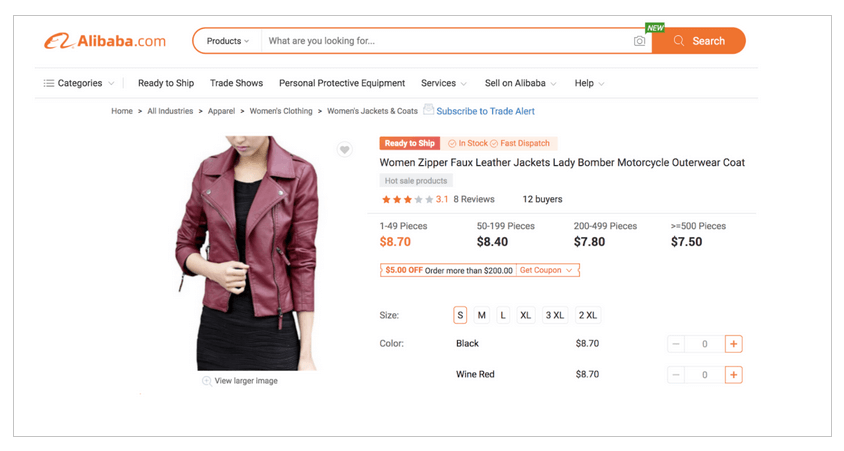
c) How can you set up a bulk or quantity-based discount on your online shop?
If you need to apply a bulk discount to achieve a particular goal all you need is to follow this tutorial that allows you to create a discount per category.
You can also give bulk discounts to your customers, based on intervals of a quantity purchased. In other words, if the quantity ordered is between a minimum and maximum value, a discount is applied.
Another type of bulk discount is a steps-based bulk discount. If your intended bulk discount will be the multiple of a specific number, then this is what you need.
Finally, this WooCommerce quantity-based discount demo is a step-by-step tutorial that will help you create your bulk discount deals.
2. Tiered pricing
Tiered pricing is a strategy that makes the price per unit of a product decrease once the quantity of a tier is purchased. In other words, it is defining the price per unit within a range. Therefore any extra number, that does not fall in the defined range, maintains its usual price.
a) What are the pros and cons of tiered pricing?
Pros:
- Make greater profit: This WooCommerce tiered pricing strategy will work for your customer base if you use it the right way. This could be more appealing if your customers are looking to buy larger quantities of the product. Because in return, it helps you secure sales by defining the price range based on rules.
- Boost customer conversion: When the customers notice that the more they purchase, the cheaper the unit cost of the product gets, they can easily make a swift decision. This pricing strategy can also attract customers who may not be able to pay the standard price. It makes it easier for the customer to buy according to his pocket.
Cons:
- Does not work well for every product: Between someone who sells dog food and soap, we can see that ‘soap’ is a necessity. It will be a great deal to apply this pricing to a product of necessity than to one that is not. Therefore if your product can’t be purchased in large quantities, it won’t work for you.
- Customers not familiar with the strategy: It may not be user-friendly enough for the customer to easily understand. Because calculating the intervals can be a bit dicey, it can create confusion and doubt in the customer’s mind.
b) When is it ideal to offer tiered pricing?
From the above explanation, we can clearly state that the best time to offer WooCommerce tiered pricing is when the purchase is in large quantities. This is better than a volume discount in some way because you make more money with this pricing strategy.
For example, let’s say that you’re selling boxes of white paper and your tiered pricing is as such:
- Tier 1: 1-5 boxes — $30
- Tier 2: 5-15 boxes— $20
- Tier 3: 20-30 boxes — $10
If a customer buys 10 boxes, you will calculate the amount by going through the tiered process.
Tier 1: 5*$30 = $150
Tier 2: 5*$20= $100
Adding everything up will give us ( $150*$100=$250). The total amount through the tiered pricing equals $250 for 10 boxes.
If we applied the same table for a volume discount, we get this:
- Group 1: 1-5 boxes — $30
- Group 2: 5-15 boxes— $20
- Group 3: 20-30 boxes — $10
10 boxes fall under group 2, which means the box per unit will be $20.
Making 10*$20, we get $200.
As you can notice, your profit margin has decreased with the volume discount strategy. Note that volume discounts also have their merits, therefore choosing the ideal strategy depends on your business.
It also works great for services, and most SAAS use it for upsells.
Wix, a popular website builder, uses it perfectly to display their offers, as you can see below.
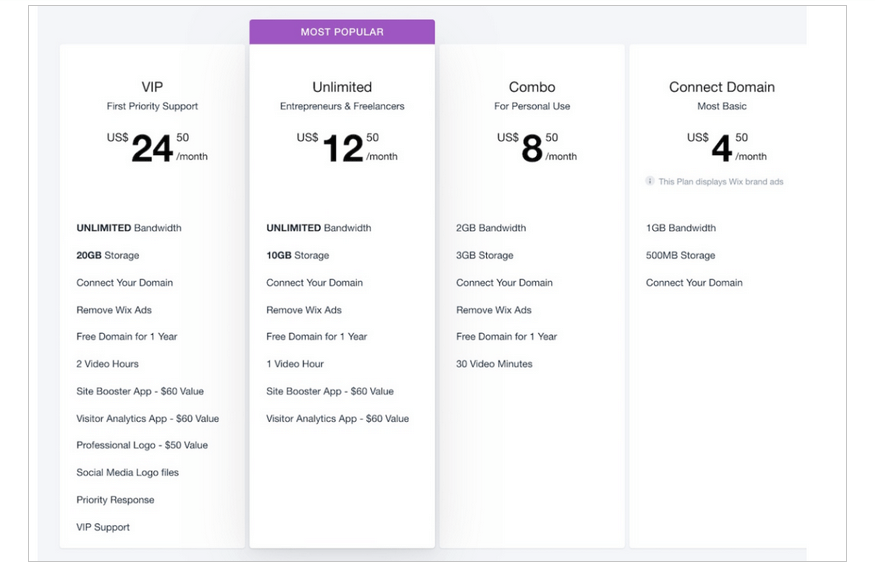
c) How can you set up a tiered pricing on your shop?
It is as simple as A, B, C. A step-by-step guide is available here and shows you how to create this dynamic pricing strategy on your WooCommerce shop.
3. Discount on cart total amount
You can offer a discount based on the total amount a customer spent on your shop. The discount can be in the form of a percentage, a fixed amount, or a gift.
a) What are the pros and cons of discounts on total orders?
Pros:
- Customer retention: One efficient way of keeping your customers is by showing them that you care about them. Knowing the exact stage of your customer’s buying journey where you need to offer this discount, can yield a great result.
- Customer referral: Happy customers are good brand ambassadors. They can easily convince their family and friends to purchase from you, and that is a sure way to increase sales.
Cons:
- Profit margin reduces: When your margins are tight, discounting becomes a risk, and some customers may only look forward to deals. That may not be good for the growth of your business.
b) When is it ideal to offer total order discounts?
Discounts, when used correctly, can yield great results. In this context, for example, offering a total order discount to a first-time buyer is a great way to nudge them to come back. You can apply the discount on their first purchase or their next purchase. You can also offer this type of discount when a customer purchases for a minimum amount (defined by you). You have a higher chance that the customer will come back to your shop.
Example: This online electronics shop decided to give a $10 fixed amount off the total order of any customer who purchases above 200$. As you can see, the discount was applied to the cart order subtotal.
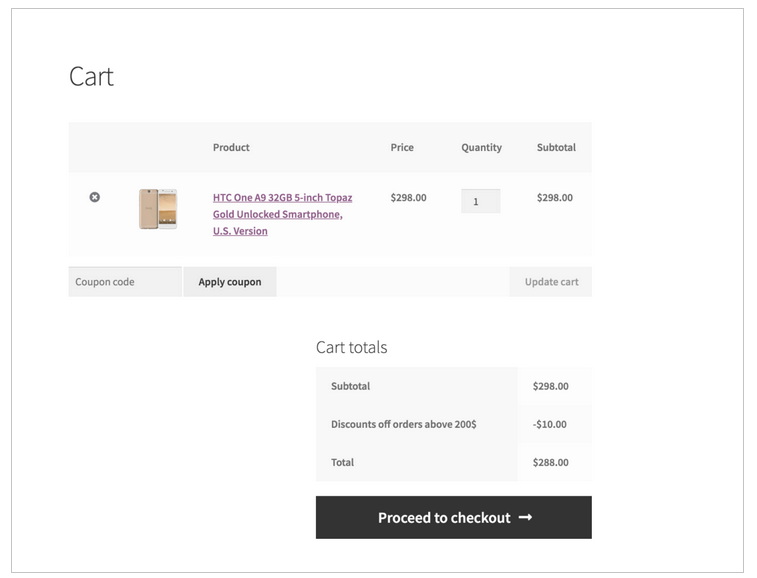
c) How can you set up a total order discount?
Setting up this discount is very easy, all you need is to define the rule and the action that will trigger the discount. Check out how total order discounts work.
4. Discount on the cheapest products in the cart
Discount on the cheapest product in the cart simply means applying a discount to the cheapest product in a customer’s cart. As a shop owner, the ultimate goal is to make a profit. Therefore using this method can help boost your sales.
a) What are the pros and cons of discounts on the cheapest product in the cart?
Pros:
- Easily create dynamic discounts ( based on customers’ purchases): This discount automatically applies to the cheapest product in the customer’s cart. Therefore you don’t need to target specific products.
Cons:
- Profit margin reduces: As with every other type of discount, every product that is sold below its actual price affects your margin. The hurt is less when you carefully select the product on which you want to apply the discount.
b) When is it ideal to offer discounts on the cheapest products?
For this particular discount, there is no ideal time. You can offer it from January to December. Most specifically, if you realize that there are a lot of abandoned carts, you can use this type of discount. This will motivate customers to come back, and at the same time protect your profit margins.
Example: This electronic shop offers a 10$ fixed amount off the cheapest product in the customer’s cart. The cheapest product was the BLU advance 5.0, the discount was applied automatically.
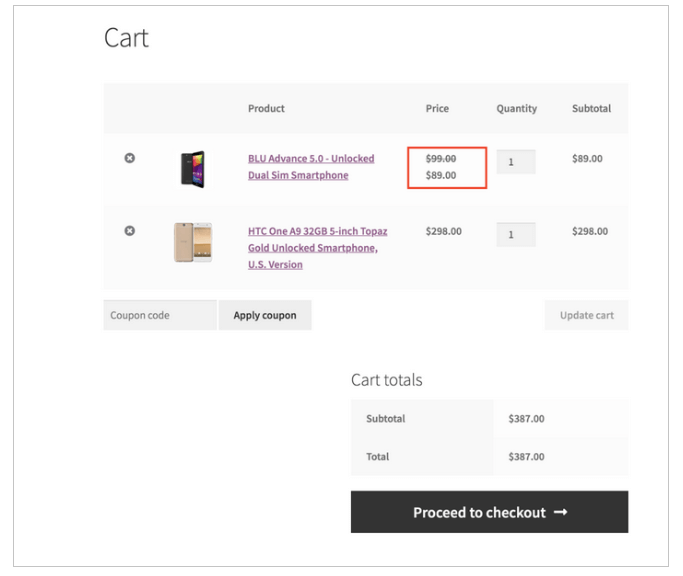
c) How can you set up a discount on the cheapest product?
This tutorial shows you how the WooCommerce cheapest product discounts work. All you need is to follow the steps and you can get your discount rolling.
5. Periodic or time-based discounts
Some call it flash sales, lightning deals, or by using words that draw attention. However, the main goal is to create a sense of urgency around the product or service. Especially now that we are in a competitive market, it is important to get creative in the business world.
a) What are the pros and cons of periodic discounts?
Pros:
- Drive traffic: Sometimes all a customer needs to convert is a deal. Targeting the right day, time, and condition goes a long way to drive more traffic to your shop.
- Brand awareness: Visibility is key! One person tells another person, and the chain continues. That is how your brand can grow in popularity.
- Move stock: When the price is reduced, it becomes an opportunity to purchase. The more people buy, the easier it is for you to make space for new arrivals.
Cons:
- Attract discount-focused customers: Having customers who only focus on perks is not good for business. The goal is to have customers who don’t wait for discount periods to buy from you.
- Image of your brand suffers: Most people have the perception that anything sold cheaply is of inferior quality. That perception does not reinforce the image of your brand visually or financially.
- Lead to price wars: Many other shops will also hold discounts from time to time, and that gives the customer a lot of choices. Therefore you may not attain your goals through discounts.
b) When is it ideal to offer periodic discounts?
Offering discounts based on customer behavior can yield great results depending on what you sell. For example, a pizza seller can offer ‘Friday deals’ because it’s the weekend and people want to have some fun. Same for massage services, fashion, and accessory shops. They will get more return because it is well-positioned, and they are satisfying a demand. The most important thing is to position your product at the right time.
Example: AliExpress calls it flash deals, and they apply this strategy by giving a discount to anybody who purchases a product from their jewellery and watches category in 48 hours.
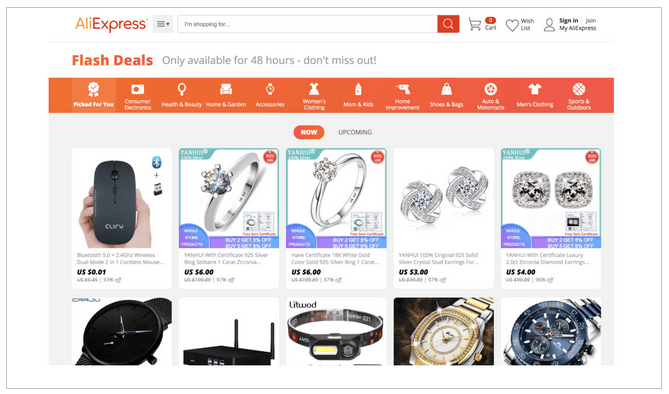
c) How can you set up periodic discounts on your WooCommerce shop?
Is this the type of dynamic pricing you want to create on your WooCommerce shop? This tutorial has got you covered! You can set any discount as a periodic discount. Moreover, no need to manually repeat it every time you need it. You can automatically plan for months ahead and let it run.
6. Loyalty discounts
People love when you find a solution to their problems. Based on the different sets of people that purchase in your store, you can satisfy each of their needs with loyalty deals. Once they are hooked, you can be sure that they will be there for a long time.
a) What are the pros and cons of loyalty discounts?
Pros:
- Build customer relationships: Your customers will develop a sense of belonging to your store. They will feel valued, and when you exceed your customer’s expectations, you are winning a loyal customer.
- Increased sales: When you have loyal customers, your sales move and you also generate more sales because your loyal customers can become your ambassadors.
- Influence recurrent customers’ decisions: Recurrent customers can feel left out, and that influence can push them to join your loyalty deals, and in return your loyal customer database expands.
- Attract new customers: When your loyalty program is well-designed, new customers will easily want to take advantage of the offer. Consequently, your numbers will begin to rise.
Cons:
- Competitive market: You will not be the only one offering this type of discount on the market. Your competitors will have such discounts too. Therefore if your strategy does not make you stand out, your customers can be swayed away by other offers.
- Difficulty in identifying loyal customers: It is very easy to put brand-loyal customers and recurrent buyers in the same group. The difference is that a brand’s loyal customer can go the extra mile to invite friends or leave a review. But the recurrent buyer might just be there for your discount offers. Therefore it will be difficult to get the best out of your loyal customers if the targeting is not well done.
b) When is it ideal to offer loyalty discounts?
There is no specific period of the year to offer this discount. But to give it more weight, and to make the customer feel valued, it would be ideal to grant them this discount after an action.
It could be after several previous purchases, previously ordered products in your store, during the festive season, or when a product is high in demand.
Example: H&M, a fashion retail store, took advantage of the preschool period to offer a discount on kid’s items if a member purchases above $60.
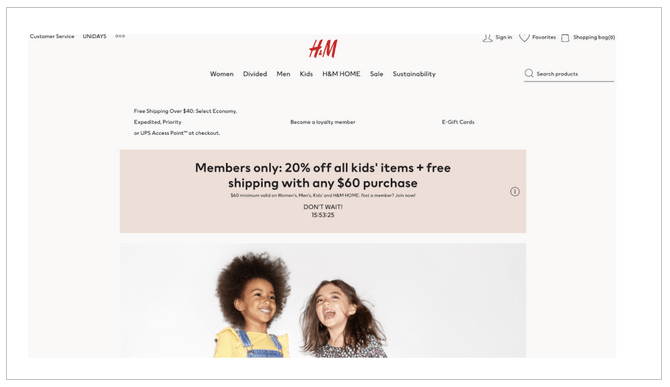
c) How can you set up a loyalty discount?
You will need to create a list of your beneficiaries. To do so, there are some steps you have to follow. Read more on discounts for member’s only tutorial, to find out how you can create this discount.
7. Free Gift
A free gift is an item given to a customer free of charge. This can serve as an inducement, to encourage a customer to buy more.
a) What are the pros and cons of gifts?
Pros:
- Brand Awareness: One of the best ways to “get your name out there” is by giving out free gifts. It is a way of creating awareness and drawing attention to our brand.
- Increase sales: When you add value to your customers through gifts, they will be willing to spend on products from your brand. The key to making customers spend more on your products is making them feel special and valued.
- Cost-effective promotion: Applying this method helps you advertise for your company at a very low price. compared to other methods like TV, Radio, Newspaper, and Social media ads, promotional gifts have a way of directly touching the emotions of the customer.
Cons:
- Low-profit margin: If your cost structure or pricing strategy is poor, it will impact your profit margin. consequently, offering free gifts will hurt your brand instead of helping it grow.
b) When is it ideal to offer free gifts?
If you are a new shop owner, you will need a strategy to promote your brand. Therefore, you need to plan on providing gift samples to attract potential customers. You can use it in different ways such as after a purchase, on the next purchase, after a specific action, or during a specific season. It can also be used during festive seasons like Black Friday, or Christmas, or to get rid of unmoving stock.
Example: Estee Lauder, a skincare shop decided to give away samples of their foundation. The rule to be followed is filling out a form and entering an activation code and you get it for free.
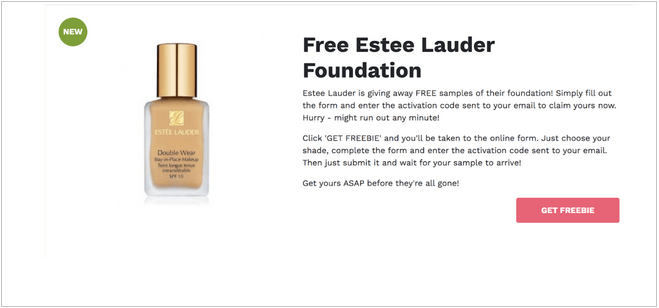
c) How can you set up a free gift on your online shop?
Implementing free gifts on your WooCommerce shop can be done in a few clicks with the conditional discount for the WooCommerce plugin. You can achieve it by reading this tutorial on free gift deals.
8. Buy One Get One – BOGO
BOGO is a way of encouraging more sales of a product by offering two items of the same type for the price of one.
a) What are the pros and cons of using a BOGO discount?
Pros:
- Get rid of unmoving products: This is very beneficial for your business when there are some products you want to get rid of and make room for new stocks.
- Attract customers: When you want to attract more people (both old and new customers) to purchase from you, it can serve as a good strategy. You just have to make sure the paying item covers the cost for both products.
Cons:
- Questions product quality: The bad side of offering BOGO is that people may question the quality of your product. In return, this can tarnish the image of your brand. They can look at your business as “inferior”.
- Run out of business: When you continually offer BOGO, it can lead to failure in business. Your profit margins will fall, and you can run out of money to restock your shop. But when used strategically, it can yield great results.
b) When is it ideal to use a BOGO discount
One of the best times to use the BOGO discount is when a product is no longer in high demand. You should know your products and the time of the year when the demand is low. Based on that information, you can strategically position it for a BOGO discount.
Example: currentcatalog.com, an online stationery brand used this method to move their sticker items off the rack, because they were not in the festive season (that is the time of the year when decoration items are high in demand). This will motivate buyers to seize the opportunity, especially when they know that they are getting double the price of one.
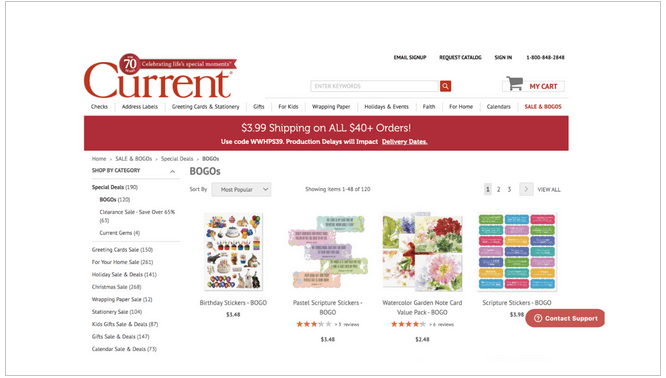
c) How can you set up BOGO on your online shop?
You can easily create a BOGO deal by following this step-by-step tutorial. It gives you a detailed explanation of how to set up a “buy N, get N for free”, “Buy X, get Y for free”, and a “Free gifts above a certain amount” deal.
9. Discounts on some products if the client purchases other
We can also call it cross-selling. It is a way of encouraging the customer to buy products related to the main product. In return, the average order size of your online store increases. Using this discount strategy has a lot of benefits. We will discuss some below.
a) What are the pros and cons of discounts on some products if the customer purchases others?
Pros:
- Market multiple products: The particularity of this discount is that it allows you to promote more than one product at the same time. Enticing the customer to buy more.
- Boost the sales of products that are upsold: When the proposed related products add value to the main product, customers may perceive it as a cool deal and not hesitate to purchase from you. You only need to give him the feeling that he is the winner of the deal, and just watch your expensive products move.
Cons:
- Customer feels pressured: If your strategy becomes aggressive, and doesn’t come at the right time, the customer will feel uncomfortable and leave. This can wash away your efforts to retain customers.
b) When is it ideal to offer discounts on some products if the client purchases others?
You can use it at three different stages of your customer’s buying journey. The first stage is –
- Before purchase: display product recommendations on your pages.
- During purchase: display your recommendations in the shopping cart, the checkout page, or in the abandoned cart pop-up or email.
- After purchase: Send follow-up emails from time to time (most especially at the right time like the end of the month, a few days before special events or holidays) to entice customers to come back.
Example: A watch seller on Aliexpress, displays other watches that are on sale to entice customers to buy more than one watch.
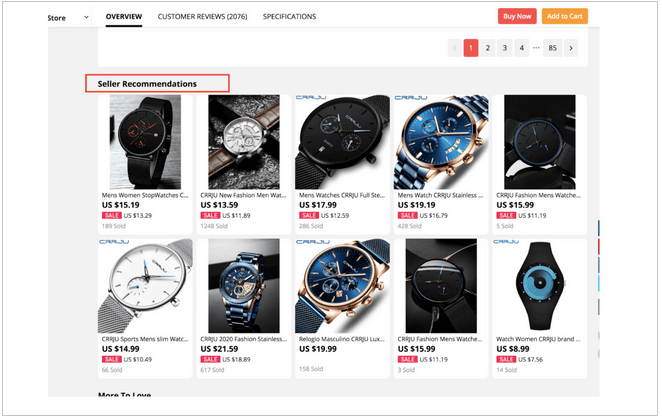
c) How can you set up discounts on some products if the client purchases others?
This guide is here to make it easy for you to set up one of the most stimulating discounts.
10. Discount on product categories, tags, or meta
Discounts-based category or tag is when you offer customers a flat, fixed, or percentage discount on products of a specific category or based on their tag or any other taxonomy. This is one of the popular ways to make upsells.
a) What are the pros and cons of offering product categories, tags, or meta discounts?
Pros:
- Increase upsells: You can easily encourage customers to purchase more expensive products and in return, you generate more revenue. Customers may not see it as expensive when they appreciate the product quality, and when you offer them an incentive in addition.
- Opportunity for cross-selling: You can easily sell out related or complementary products. For example, a fitness fashion seller offers a discount on the category of sportswear and socks if the customer buys a sports shoe. That is cross-selling. The products complement each other, therefore the customer can be tempted to buy into your offer.
Cons:
- Limits the customer: If the customer does not find an interest in the product you are discounting, he will look at what your competitors have to offer.
b) When is it ideal to offer product categories, tags, or meta discounts?
Product categories, tags, or meta discounts are useful when the customer purchases a product in large quantities. This increases the average order size on your online store.
Example: Alixepress.com offers a flash deal on its “Accessories” category, and the Yanhui store is giving a 15% discount off its Zirconia Diamond earring if the customer purchases 15 pieces or more.
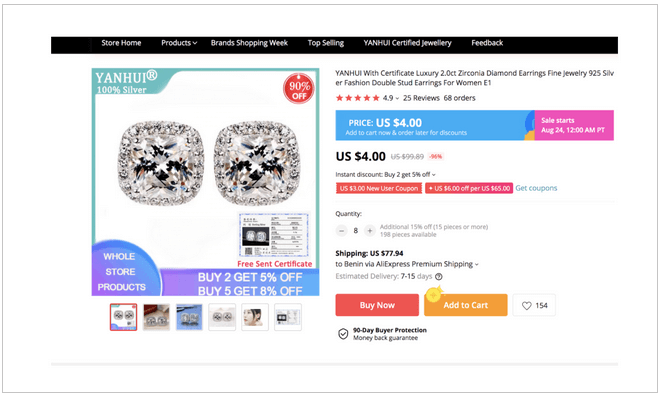
c) How can you set up the product categories, tags, or meta discounts?
Creating a WooCommerce product category, tags, or meta discount is not a complicated process. Click on the link above for a detailed tutorial.
11. Location-based discounts
Discounts based on location simply indicate that you can offer incentives to your customers based on their location of purchase. As you begin to widen your market to other regions and countries, shipping costs can vary, hence the need to dynamically apply a discount strategy. There are different types of dynamic pricing strategies you can use. You can offer discounts based on shipping/billing state or country, discount on a product, or order subtotal if purchased from a specific country or state.
a) What are the pros and cons of location-based discounts?
Pros:
- Increase in sales in specific locations: You have the power to make some locations work in your favor. People are drawn to affordable prices, therefore if you aim to sell more in a specific location, this dynamic pricing strategy can help you achieve that goal.
- Location-based visibility: This is a marketing strategy that works when you want to gain popularity in a specific location. When Word-of-mouth and referrals are used effectively, you can quickly move to the front line.
- Convenience: It encourages the customer to align with your preferred location of purchase. Because the result for you is to gain more money and not to lose it.
Cons:
- Market competition: If the market is saturated in the specific location you are targeting, it will be difficult for you to make sales with this strategy.
b) When is it ideal to offer location-based discounts?
If you have plans to open a distribution center in a specific region or country, this could be part of your marketing strategy. It will help you a lot in building your visibility and gaining territory.
If your goal is to widen your network and go global, this discount can be useful, and you can use it around Christmas, New Year, or special holidays. This can facilitate shipping products to friends and relatives in other countries.
Example: If the shipping country is China, apply 50% off the flat rate of the customer shipping fees
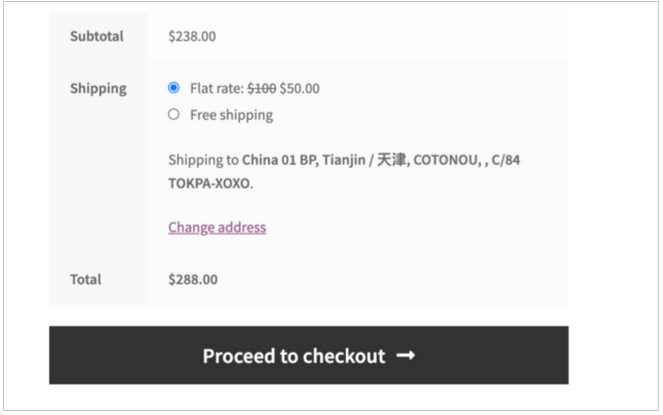
c) How can you set up a location-based discount?
If you are trying to expand your business to new territories, then you should use this strategy.
This tutorial shows you how to create a dynamic discount based on location.
12. Discount on payment gateways
There are hundreds of payment gateways out there, some are convenient for the shop owner, while others are convenient for the customer. Therefore one of the ways to guide the customer towards the payment gateway that is convenient for the shop owner is by offering deals.
a) What are the pros and cons of payment gateway discounts?
Pros:
- Reduce cart abandonment: Sometimes the only thing that stops a customer from buying a product can be the shipping cost or the charges linked to the payment gateway. Offering them a discount could be the actual nudge they need to take action.
- Increase customer satisfaction: Some customers are satisfied when they feel that you contribute to their buying process. This could even lead them to bring more customers your way.
Cons:
- Limit customer choice: Some customers can feel limited to one choice and abandon the process. When a choice is not convenient for a customer, it pushes him to look elsewhere, and there you lose.
b) When is it ideal to offer payment gateway discounts?
The best moment to offer a payment gateway discount is when your customer has an exit intent. In other words, he decides to leave your store without purchasing a product; that behavior is a sign that there is a problem. There are different ways to draw back his attention, for example, by using an exit-intent pop-up message with an attractive offer. That, for sure, will make him think twice.
Example: Customer A purchased a phone from this electronic shop, and they gave him a discount because he used the “Direct Bank transfer” method, if he uses any other method on the list, he will pay the initial amount fixed for the product.
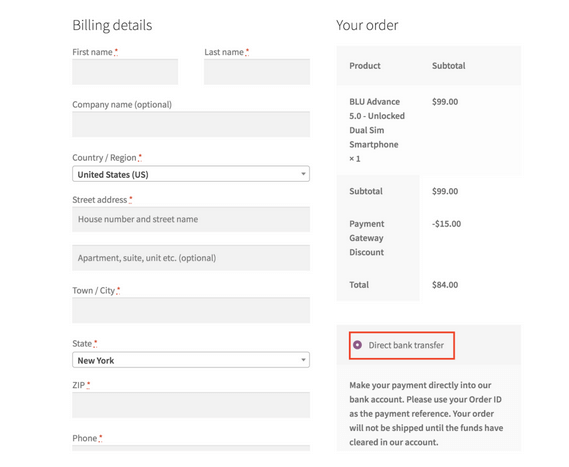
c) How can you set up a payment gateway discount?
The process is very simple. You have a detailed explanation in this tutorial. Note that you will have to choose the payment gateways that work best for you. You will also find a lot of information on the internet regarding the advantages and disadvantages of each payment gateway.
13. Discount based on selected store currency
All the shop owner needs is to make a profit. Therefore, even the little details count. Depending on the location from which your customer is buying, you can gain or lose money in the conversion process. That is why you can persuade the customer to purchase with the currency that is convenient for you by offering him an incentive.
a) What are the pros and cons of offering store currency discounts?
Pros:
Convenient for the seller: As a shop owner, it helps you stay within your profit margin without the fear of losing a lot of money due to a conversion.
Cons:
Limits the customer: If your offer is inconvenient for the customer, he will look for another way to get what he wants, because nobody wants to be a loser when it comes to spending money.
b) When is it ideal to offer store currency discounts?
When the exchange rate is to your advantage, it is a good opportunity to apply a dynamic pricing strategy. But the most important thing you have to do is analyze the benefits you get from a customer’s purchase.
If it is a significant amount being paid, then you have to go the extra mile with an incentive.
Therefore, you can set a rule that states that any customer who purchases above a certain amount would get a discount on currency x (the currency of your choice).
Example: This electronic shop offers a $20 fixed amount off the product price if the shop currency is in USD, and from the TV /Home Theater category.
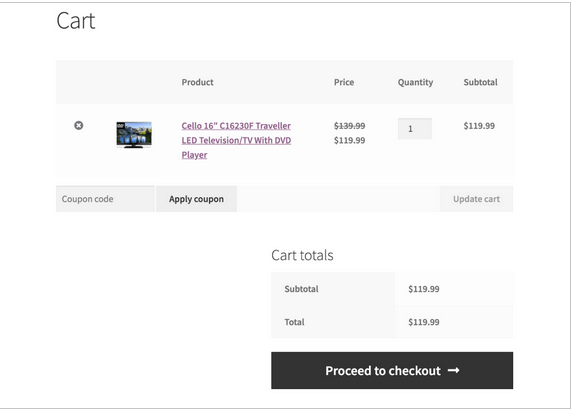
c) How can you set up a store currency discount?
To encourage your customers to make payments in your preferred store currency, read this tutorial on how to create a discount based on store currency. It will help you create this type of discount on your store.
14. Discount based on user-role
Woocommerce dynamic pricing based on role are prices or discounts that are available to your customers based on their roles in your e-commerce store. The roles that exist in a typical WooCommerce store include Customer and Shop Manager. Other roles that can be found within a typical WordPress site include Administrator, Editor, Author, Contributor, and Subscriber. There are plugins that you could use to create more roles and define their capabilities, within your site.
a) What are the pros and cons of user-role-based discounts?
You have nothing to lose with this offer. Simply because it is tailored to the profile of each customer. It is rather the client that loses if he doesn’t take advantage of your discount.
Pros:
Converting potential/new customers to loyal customers: Studying customer behavior can help you define a strategy that can turn him into a loyal customer. This helps you give a special treat to each customer.
Increase sales: A customer who knows that he has a privileged place on your online store will not think twice before buying. That is a good thing for your business.
b) When is it ideal to offer user-role-based discounts?
When you want to encourage a customer to buy more from you, this offer is useful. You can give him a discount based on his previous orders on your online store. Another good time to promote this deal is when you want to quickly sell a particular product. Target users of that product and give them a discount.
Just like airlines, we have economy, business, and first-class. They all come with benefits, but the benefits differ depending on your class. This means that the more you spend, the more benefits you have access to. That is a great strategy for user-role-based discounts.
Example: If the customer’s role in the store is ‘wholesaler’’, apply a $20 fixed amount off his order subtotal.
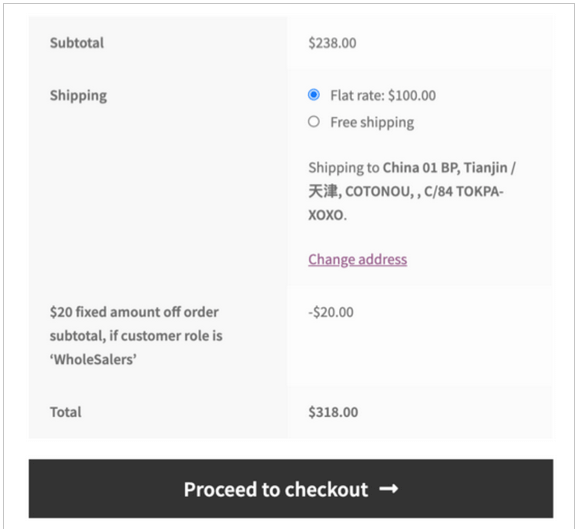
c) How can you set up a user-role-based discount?
To set up a user-role-based discount on your shop, all you need is to click on this link for a detailed explanation.
15. Customer email domain discount
You can offer any discount to customers based on their email address or with a specific domain name. Bear in mind that it all depends on your goals and aspirations.
a) What are the pros and cons of email domain discounts?
There are no disadvantages for you as the shop owner because it is a choice you make. It is not a very common WooCommerce dynamic pricing strategy. Therefore you have more to gain than to lose.
Pros:
Customer retention: You can decide to offer this discount to all customers in a group or a company with a specific domain name. This increases the value of the customer or company and pushes them to loyalty.
Increased sales: One action leads to the other. When you can retain your customers, the result of repeat purchases is an increase in sales.
b) When is it ideal to offer customer email domain discounts?
Maybe you want to retain employees of a certain company because of their power of purchase. This is the deal you need! It is also useful when you are looking forward to a partnership with a company. It could be a private renowned company, a government contract, or any business that can directly impact your sales. Proposing this deal can become a win-win deal that will satisfy both parties.
Example: A fashion store decided to offer an email domain discount to every customer that works with the company called “Orion Origin”. This means that if any employer from “Orion Origin” buys from the shop and enters the email domain name of the company, he/she automatically gets a 15% discount.
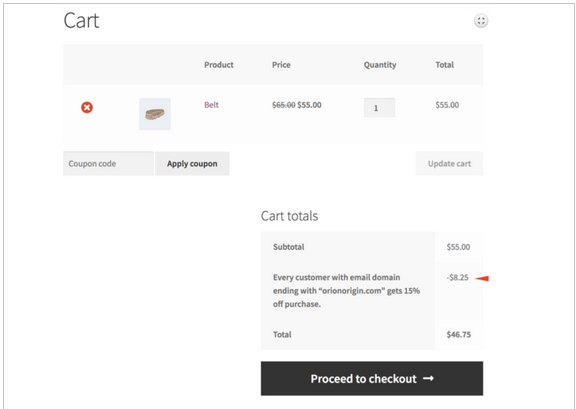
c) How can you set up an email domain discount?
An email address is usually structured as pseudo@domain.com, whereby domain.com is the domain name. It could be Gmail, Yahoo, Hotmail, or a company’s name. Based on that, you can dynamically offer any type of discount just by following this step-by-step tutorial.
16. User groups based discounts
The main difference between ‘user-role’ and ‘user groups’ is that in the first case, the discount is applied to an individual, and in the second case, to persons belonging to a group.
It allows you to grant exclusive discounts to members of a group created by you (the shop owner).
a) What are the pros and cons of user-groups-based discounts?
As a shop owner, there is nothing you lose if your WooCommerce shop offers this type of discount. The most important benefit you get is retaining your customers and increasing your sales.
b) When is it ideal to offer user-group-based discounts?
Just like the airline scenario we mentioned above, it can also be used in this case. With the difference that ALL the members of that group will take advantage of it.
You can use it to reward your most loyal customers during special occasions like Black Friday, Summer vacations, pre-school periods, Christmas, and any other time you deem fit.
Example: If a customer belongs to a specific group (VIP member), then he gets 50% off his order subtotal.
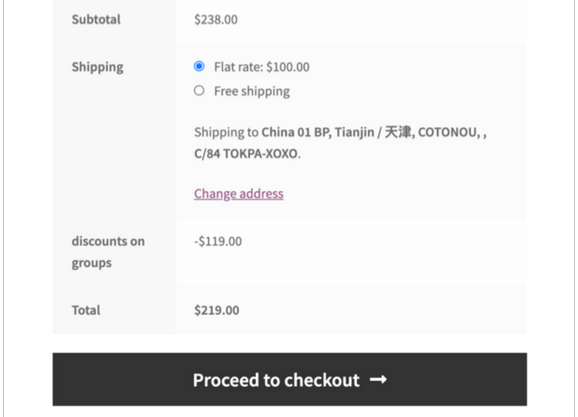
c) How can you set up the user groups based on discounts on your WooCommerce store?
There are three different ways of offering membership discounts, and each of them will produce a result based on the goals you set. To discover more about this dynamic pricing strategy and how to set up member discounts check out this tutorial.
17. Discount for affiliates
It is possible to give discounts to customers who land on your shop through affiliate links. With this strategy, everyone is rewarded. The affiliate gets a reward based on his referrals, the referred customer gets a discount, and finally, the shop owner gains a customer. However, this section will focus on discounts for customers that come through affiliate links. You can learn more about affiliate marketing here. You can also join our affiliate program here.
a) What are the pros and cons of discounts for affiliates?
Pros:
Brand awareness: Many people will get to know your brand through affiliates. Affiliates are persons whose role is to bring customers to a business. The more your brand is seen by many people, the more visibility you get.
Attract new customers: Dynamic pricing is a powerful motivation towards conversion. Therefore a lot of potential customers will be willing to shop from you because of your offer.
Cons:
Cost of system installation: Installing an affiliation system is not a one-click affair. It comes with a cost and a well-defined strategy. If you don’t have the means to invest in this system, it will be difficult to reap the benefits associated with this strategy.
b) When is it ideal to offer an affiliate discount?
You can give out an affiliate discount any time you feel the need to boost your sales. But most especially if you are a new shop owner, you will need to do some marketing. At this stage of your business, it will attract new customers and bring some visibility to your shop. Therefore you should consider this in your marketing strategy.
Example: As part of their product launch strategy, an electronic shop gave a $20 discount off order subtotal to any customer that lands on the shop via affiliate link A.
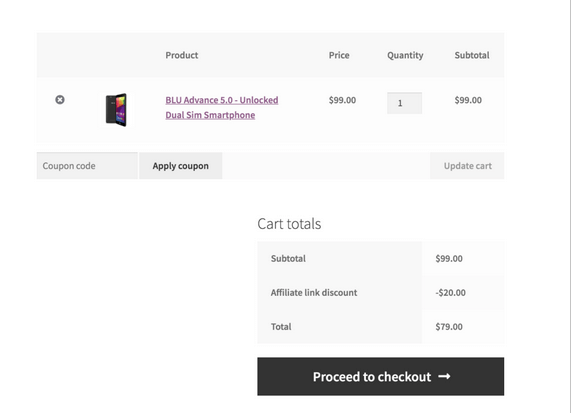
c) How can you set up affiliate discounts?
The process is seamless when you follow this tutorial that shows you how to set up a WooCommerce affiliate links discount. All you need is to create a product list and the conditional rule for the discount to work.
18. Discount based on shipping fees
Discount on the shipping fee means reducing the amount a customer has to pay for the delivery of his product. The delivery fee is always separated from the product price, combining both can sometimes be expensive for the customer, hence he can be discouraged and abandon the cart.
a) What are the pros and cons of discounts on shipping fees?
Pros:
Effective marketing tool: A recent study by Statista shows that 63% of consumers abandon their shopping carts when shipping rates are too high. You can look at it as an effective marketing tool and not just a delivery option. If you use the right strategy, you can leverage it to maximize your sales opportunities.
Cons:
Affect profit margins: One disadvantage that is general to most sales is that discounts can reduce your profit margins.
b) When is it ideal to offer discounts based on shipping fees?
Are you asking yourself why you should offer a discount based on the shipping cost in a peak season? The reason is demand!
From back-to-school to holiday sales, through the last months of the year, there is a lot of shipping going around the world during those peak seasons. Therefore carriers and shipping services know that they can raise their price and people will still pay.
Therefore it is recommended to target the pre-holiday/ preschool seasons. Especially if that is the time your products are high in demand. According to woocommerce.com, 59% of shoppers look for sales and gifts an average of 42 days before the holidays. To receive them right in time for the festive season.
Another time you can offer shipping discounts is when the customer purchases above a certain amount. Therefore offering a discount on the shipping will highly motivate him to buy that product.
Example: Amazon uses the second strategy by offering ‘free shipping’ to customers who purchase from $25 and above.
c) How can you set up shipping fee discounts on your shop?
You can create a WooCommerce dynamic pricing on shipping methods by reading this tutorial. It provides you with a very detailed explanation of how to go about it.
19. Discount based on shipping method
Discounts can be a reward to customers who select a specific shipping method in your WooCommerce store. A particular shipping method would cost less to you ( shop manager) than others, and you need a way to make users choose it over the others. There comes the need to offer a discount on the shipping method; so that it spurs the interest of customers to choose it over other shipping methods.
a) What are the pros and cons of discounts on shipping methods?
Pros:
Save money: It makes you (the shop owner) save some money on the shipping method of your choice. If you are comfortable with a particular shipping method then this discount is what you need to win over your customers. All you have to do is partner with a shipping company and take advantage of the discounts they offer.
Cons:
Inconvenient for customers: Online buyers today are very quick to leave an online store if the offers they see do not suit them. This could lead to low conversion on your site. The customer can feel trapped and will try other options from your competitors. Hence, a need to offer shipping discounts that can satisfy customer needs.
b) When is it ideal to offer discounts based on shipping method?
As a shop owner, the best time to offer this type of discount is during an exit intent. showing them that they can get a discount by using a specific shipping method can encourage them to complete their buying process.
Example: A shop owner creates the following shipping method discount that implies that a customer gets 40% off the cart total if the shipping is flat rate shipping.
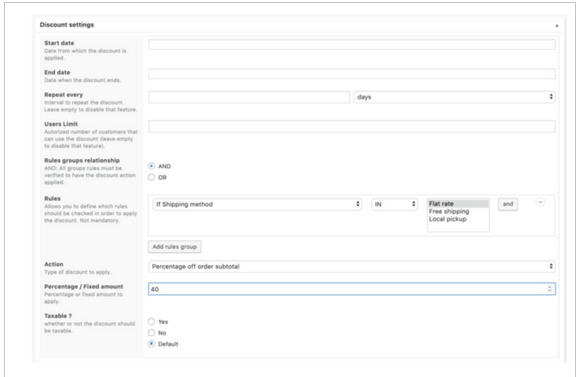
c) How can you set up shipping methods discount on your shop?
This tutorial on the WooCommerce shipping method discount will help you set up your discount in four easy steps.
20. Discount based on shipping/billing state or country
One way of inducing customers to ship or bill their products to your preferred location is by enticing them with discounts. As the shop owner, you get to determine the delivery location that is convenient for your business, and customers can only buy into your idea if they see it as a good deal.
a) What are the pros and cons of discounts based on shipping/billing state or country?
As mentioned in the two previous dynamic pricing strategies, they all share the same advantages and disadvantages. It will help you increase sales in a particular state or country. In doing this you can save money, that could have been extra charges. The other side of the penny is that, if your deal is not convenient for the customer, or he feels like the loser in the game, this strategy will not yield any fruits.
b) When is it ideal to offer discounts based on shipping/billing state or country?
At a point in time, you would want to extend your business to some countries or states. after properly analyzing the possibilities, if you have more to gain than to lose, you can leverage this discount type. It can be used to target customers of a particular state or country, to increase your sales.
Example: A shop owner takes off 40% of running shoes if the customer’s billing state is ‘Borno’.
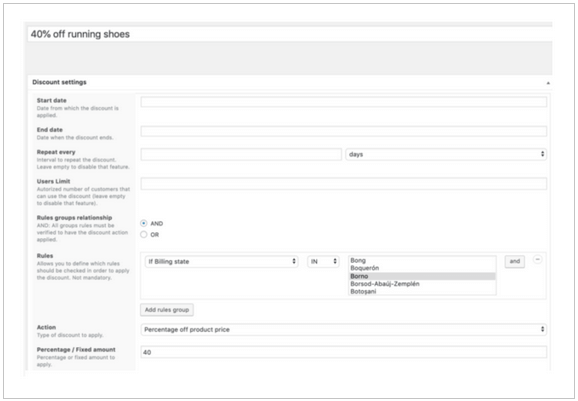
c) How can you set up discounts based on shipping/billing state or country?
Practical examples of how to set up discounts based on shipping/billing state or country will help you create your own. You will learn how to create this WooCommerce dynamic pricing on the product price, cart total, and shipping fees.
Conclusion
There you have it, 20 WooCommerce dynamic pricing strategies with their advantages and disadvantages, setups and ideal moments to be used.
We hope that you have found this article informative and that it inspires you to get creative with your WooCommerce dynamic pricing and discounts.
Let us know your thoughts and ideas in the comment section below.

